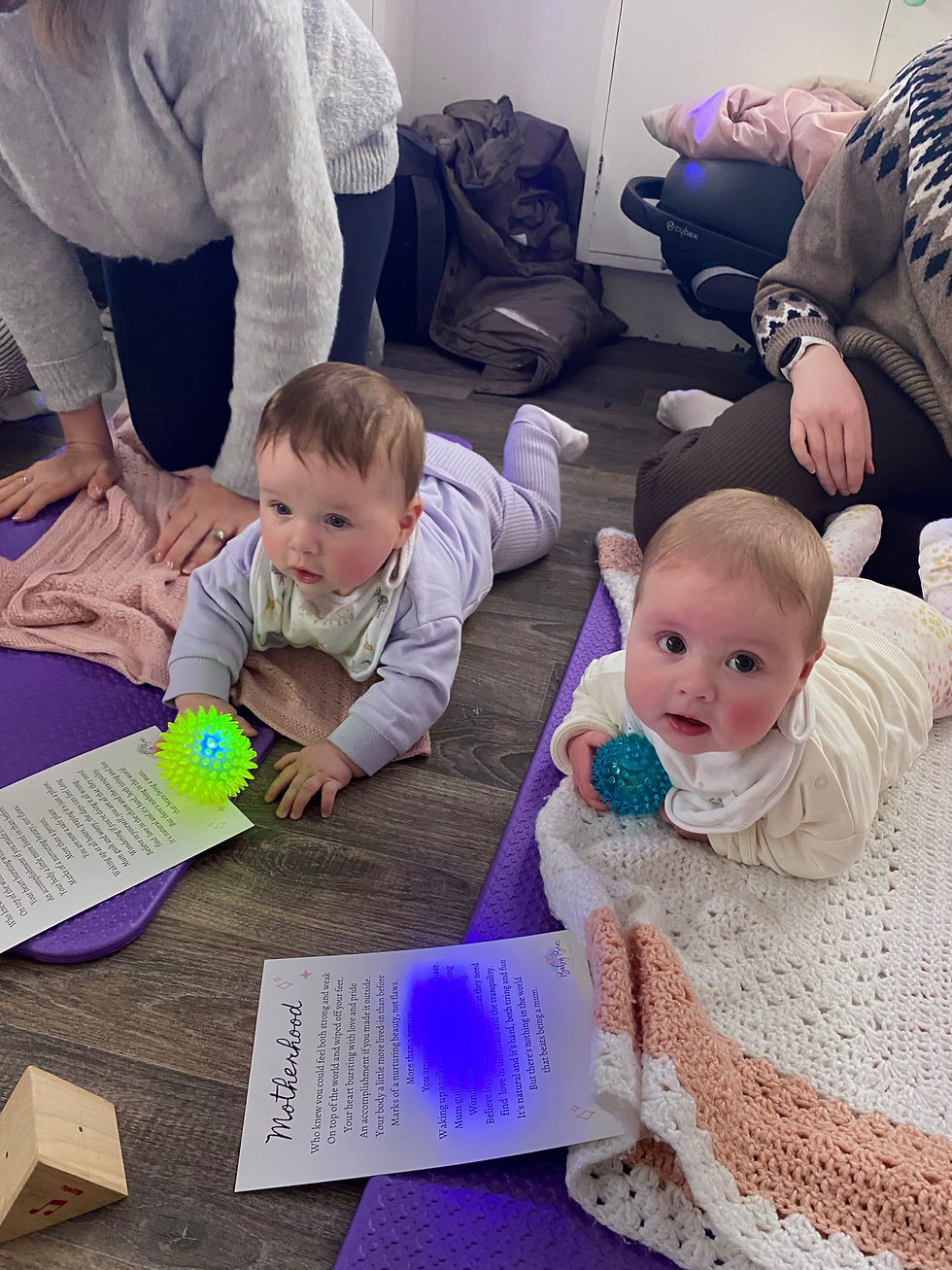Shake, rattle and roll!
- babybearmassage

- Jul 28, 2020
- 4 min read
Updated: Apr 17, 2023
Rattles, shaker toys and balls are a brilliant toy for babies from newborn. If you haven't got a shaker toy, they are super easy to make. simply fill a tupperware dish with a lid with rice or lentils and secure the lid! or a bottle filled with buttons would be brilliant too.
Looking and Noticing
Babies’ vision is improving from the day they are born. They can see objects further away and can also see colors from about 6 weeks, though they still prefer objects with strong color contrast (such as black, white, and red).

*Hold up a rattle in each hand. Shake one and watch if your baby focuses on it. Give her a few seconds, then shake the other rattle. Wait for her to focus on that one. Shifting gaze between two objects means babies can focus their attention (and vision) on objects they find interesting.
Grasping Begins

Your baby is now able to look at an object and move her hand in that direction to grab it. This is how hand-eye coordination develops. Soon your baby will be transferring toys or other small objects from one hand to the other (sometimes pausing to mouth them for a bit).
*Offer your baby two rattles within reaching distance. Let him reach for and grasp the one he likes best.
*Offer your baby two objects to hold. Once she is holding one, offer her a second one. At first, she will drop what she is holding to grab a second object. Over time, she will learn to hold two things at once.
Into the Mouth!

Babies are curious about everything—and mouthing toys (and almost anything else!) is an important way that babies explore their world. The mouth is a highly developed nerve center so mouthing tells babies a lot about an object—what texture it is, what it might do, how large it is, what it tastes like, and more. Mouthing objects can also help with teething pain, which can begin as early as 4 months. Babies will continue to mouth objects into their toddler years.
Rattles, shakers and balls can be great toys to explore and put in their mouths ( under adult supervision!)
Rolling and Crawling and Cruising, Oh My!

It’s a whole new world for babies as they roll, sit up, crawl, pull up, cruise along furniture, and sometimes begin to walk. These new physical skills, while perhaps unnerving for you, are exciting for your baby because they offer freedom to try new ways of moving and playing. This active play takes up much of their waking hours—so don’t be surprised if you see changes in your baby’s sleeping patterns, such as more night-time wake-ups, while he is working on these new physical skills.
Side line play is the first stage or rolling and an excellent activity for tummy time! Suitable from newborn.
Lie baby on their side with interesting toys for them to reach and explore.
You'll notice even our tiny babies can manage a two handed hold in this position. Make sure you change sides each time you play , so babies get chnace to play on both sides of thier bodies. This gives them lots of chance to kick thier legs, arms and reach, our wriggly babies might even roll from this position.

Use the ball or rolling toy - for our younger babies show them the ball above their eye line (aiming for above their nose rather than their forehead so they are not straining their necks backwards) and open up little hands so they go around the curve of the toy/ball.

Older babies we are looking for a bit of bilateral co-ordination as both hands come towards the ball to hold it. Encourage them to keep trying if they don't manage this initially. This is brilliant for tummy time!
For our sitters we are going to roll the ball towards them encouraging hand to eye co-ordination and their balance skills. Encourage them to start to roll the ball
back to you, with practice they'll get there!
If your baby can't quite stay up on their knees to get in the crawling position , you can support them by placing their hips in between your legs and supporting under their tummies ( this is called boxing!)
This will help strengthen their core, arm and shoulder muscles needed to crawl. Place the ball just in arms reach for babies to explore whilst in this position.

Once baby is crawling using toys for kneeling support and standing will help encourage standing and strengthen their legs and hips to stand. It takes a lot od practice to go from crawling to standing , using an activity table on it's side can help encourage babies to kneel.
Letting them play the the table with your hands supporting hips or at the couch or chair with toys to distract. Remember to give lots of positive feedback, encouragement and cuddles!
Remember all babies meet milestones in their own time. No two babies will have the same timeline from rolling, crawling to standing.
If you have concerns about your babies development, please contact your health visitor or GP.
I Hope you enjoy these activities, let me know if you try them
Elisa xxx
To find out more about how to support your babies development through play , join us for a class. We'd love to welcome you .
















Comments